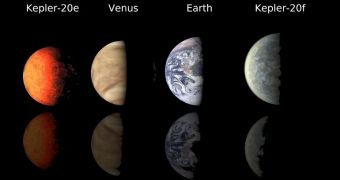Experts handling the science data return of the NASA Kepler Telescope announced yesterday, December 20, that the observatory was able to identify the first exoplanets that are nearly identical to Earth in size. The worlds are not located in their parent star's habitable zone.
This is the second major discovery to come from the NASA planet-hunting telescope over the past couple of months, since its science team announced the discovery of the first extrasolar planet living in its star's habitable zone.
The two rocky, Earth-sized worlds, called Kepler-20e and Kepler-20f, represent the first findings of their kind, and are also the smallest exoplanets ever discovered. Finding worlds such as these two is the main reason why Kepler was developed in the first place.
The most important question that was on anyone's mind after the planets were announced was whether or not they orbit inside their star's habitable zone. Unfortunately, the Kepler team said, that is not the case, as both worlds are extremely close to the star's surface.
This most likely makes their surface temperatures exceed several hundreds of degrees, and also makes the planets themselves tidally locked to their parent star. The Moon, for example, is tidally locked to Earth, always displaying the same face towards our planet.
Both Kepler-20e and Kepler-20f orbit their parent star in a much shorter time than it takes for Mercury to orbit the Sun. The former only needs 6.1 days to do so, while the latter completes a full orbit in 19.6 days. Mercury takes about 88 days to spin around the Sun once.
The exoplanets are located about 1,000 light-years away, in the Kepler-20 star system, which can itself be found in the constellation Lyra. The star has 5 planets orbiting it, of which the two recently discovered ones are the fourth and fifth.
What is remarkable about them is that they are very small, when compared to most other planets that were identified until now. Kepler-20e, in fact, is smaller than Venus, with a radius just 0.87 times that of Earth. Its companion, Kepler-20f has a radius about 1.03 times that of our planet.
“The primary goal of the Kepler mission is to find Earth-sized planets in the habitable zone. This discovery demonstrates for the first time that Earth-size planets exist around other stars, and that we are able to detect them,” Francois Fressin explains.
The expert, who was the lead author of a study detailing the findings, is an astronomer with the Harvard-Smithsonian Center for Astrophysics (CfA), in Cambridge, Massachusetts. The work is published in a recent issue of the top scientific journal Nature.
“In the cosmic game of hide and seek, finding planets with just the right size and just the right temperature seems only a matter of time. We are on the edge of our seats knowing that Kepler's most anticipated discoveries are still to come,” Kepler deputy science team lead Natalie Batalha explains.

 14 DAY TRIAL //
14 DAY TRIAL //